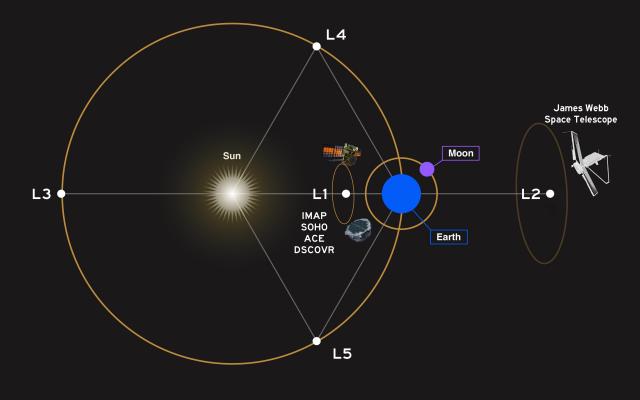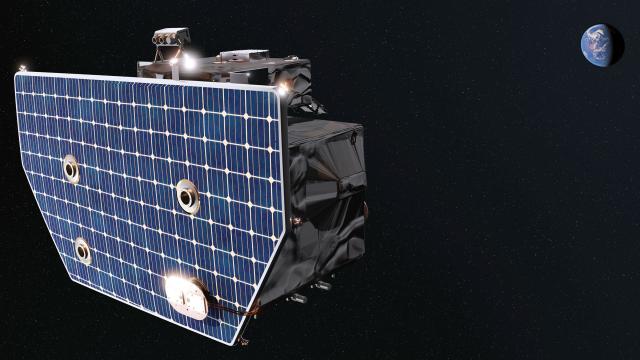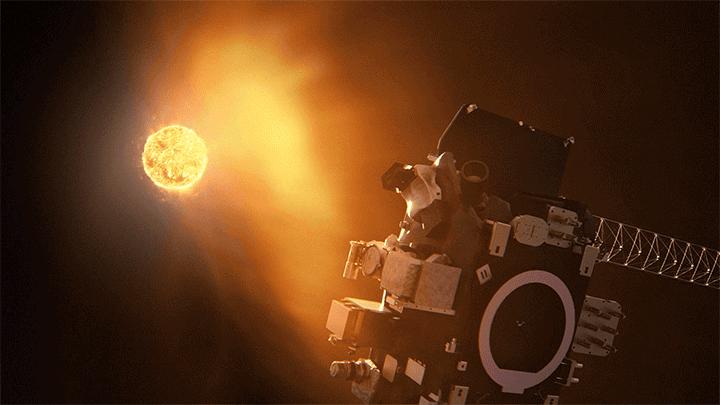NASA is planning the launch of The Interstellar Mapping and Acceleration Probe (IMAP), a mission to explore the edge of the heliosphere, a huge bubble created by the Sun’s wind that encapsulates our entire solar system.
IMAP will also explore and chart the particles that make up interplanetary space, helping to investigate two of the most important overarching questions in heliophysics (the study of our and other suns): how charged particles from the Sun are energized, and how the solar wind interacts with interstellar space at the edge of that bubble. IMAP will provide real-time observations of the solar wind and energetic particles critical to improving space weather predictions.
IMAP’s launch is planned for Sept. 23, 2025, at 7:32 a.m. ET, about 30 minutes after sunrise. The glare of the rising sun will make it difficult to see from Raleigh, but observers along the coast might catch the rocket rising in the east.
 missions at the L1/L2 lagrange points (NASA)
missions at the L1/L2 lagrange points (NASA)
After launch, IMAP will head for the L1 point, or first LaGrange point, about a million miles from Earth. LaGrange points are points of gravatational balance that allow missions to operate for many years with minimal fuel.
IMAP and the other spacecraft atop the SpaceX rocket will join other heliophysics missions at the L1 point between the Sun and Earth like the Advanced Composition Explorer (ACE) which analyzes particles from near and far, ranging from solar wind ions to galactic cosmic ray nuclei; the Solar and Heliospheric Observatory (SOHO), a joint NASA-ESA mission designed to study the Sun from the inside out; and DSCOVR, the joint NASA/NOAA space weather station that helps provide alerts and forecasts for geomagnetic storms that could disrupt power grids, satellites, telecommunications aviation and GPS.
Instruments aboard IMAP
The mission has 10 instruments designed to observe different particles, electromagnetic fields and ultraviolet light across a vast range of energies.
IMAP-Lo: maps low-energy energetic neutral atoms (ENAs), particles created at the edge of the solar systemIMAP-Hi: maps medium-range ENAs from the edge of the heliosphereIMAP-Ultra: maps ENAs at their highest range from the edge of the heliosphereGLOWS: studies the ultraviolet glow created by the solar wind to understand how it evolves over timeSWE: measures electrons found in the solar windMag: Magnetometer measuring interplanetary magnetic field that originates from the SunSWAPI: measures ions from the solar wind from our own Sun as well as particles from beyond the solar systemCoDICE: measures the mass and electric charge of ions originating from both interstellar space and the solar windHIT: Particle telescope studying high-energy ions that come from the solar wind and deep spaceIDEX: studies interstellar and interplanetary dust particles
Also atop the SpaceX rocket alongside IMAP will be two other missions bound for L1: NASA’s Carruthers Geocorona Observatory, and NOAA’s SWFO-L1 (Space Weather Follow On-Lagrange 1) spacecraft.
 Carruthers Geocorona Observatory satellite leaving Earth. Credit: NASA/BAE
Carruthers Geocorona Observatory satellite leaving Earth. Credit: NASA/BAE
The Carruthers Geocorona Observatory, or Carruthers mission, will study Earth’s exosphere, the outermost layer of Earth’s atmosphere. This is the first mission dedicated to studying changes in this expansive and extremely thin part of the atmosphere. Researchers will use its data to better understand how the shape, size and density of the exosphere changes over time and what causes those changes.
The mission is named for Dr. George R. Carruthers, inventor of the ultraviolet camera/spectrograph placed on the surface of the Moon during the Apollo 16 mission. This first moon-based observatory also delivered the first images of Earth from a distance revealing extent of the hydrogen atmosphere, the polar auroris and what we call the tropical airglow belt. The Carruthers mission builds on his work.
 Space Weather Follow On – Lagrange 1 (SWFO-L1) will keep a watchful eye on the sun and near-Earth environment for space weather activity (NOAA)
Space Weather Follow On – Lagrange 1 (SWFO-L1) will keep a watchful eye on the sun and near-Earth environment for space weather activity (NOAA)
The Space Weather Follow On-Lagrange 1 (SWFO-L1) mission carries a suite of instruments to make real-time measurements of the solar wind, thermal plasma and the magnetic field.
SWFO-L1 will have a Compact Coronagraph (CCOR) instrument to detect coronal mass ejections. SWFO-L1. (NOAA’s GOES-19 weather satellite which serves the eastern half of the United States has a similar CCOR instrument.) The pair will work together to improve space weather forecasting, especially of geomagnetic storms.
